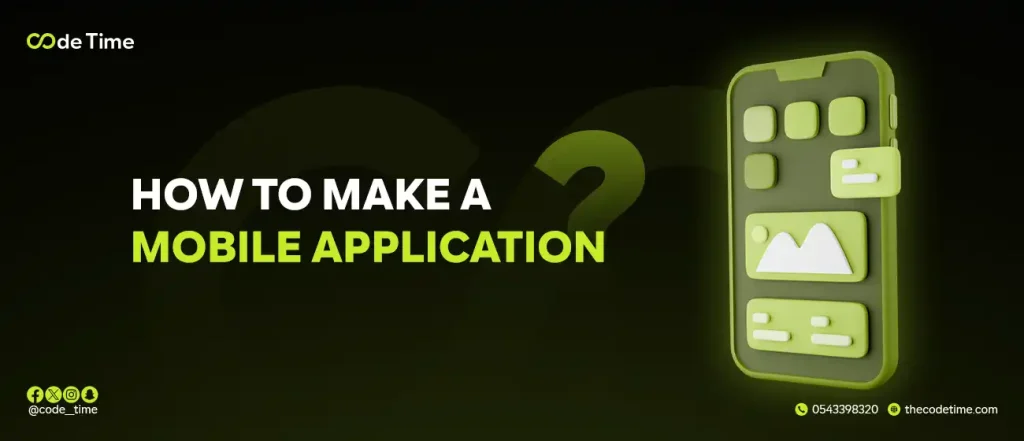The use of mobile phones has become an essential part of many people’s lives today, as millions of people spend long hours on their phones in various daily activities, including shopping and purchasing products. As a result, companies started creating their own mobile applications to reach the largest number of target customers. If you run a small or large business, it is necessary to know how to make a mobile application in order to ensure a continuous presence in the market and appear to customers in a professional manner. In this article, we will learn how to make a successful professional mobile application.
Table Of Content
ToggleThe importance of creating a mobile app
Creating a mobile app is no longer just entertainment as some people think, but has become a basic necessity to reach the smartphone user base, which is increasing day by day. This is why entrepreneurs turn to knowing How to make a mobile application because of its many benefits, including:
- Build customer loyalty
The professional application contributes to enhancing direct and continuous communication with customers, which strengthens the relationship with them and increases their confidence, which is reflected in their loyalty to the brand.
- Increase sales
The application allows products and services to be displayed in an organized and attractive manner, which makes it easier for customers to make a purchase decision, and thus contributes to raising conversion rates and increasing sales volume.
- Expanding market access
By publishing the application on different platforms, you can promote your products on a local and global scale, which helps you reach a larger segment of customers, regardless of your geographical location.
- Outperforming competitors
Owning a mobile application gives you a competitive advantage, as you can provide innovative services and distinct marketing ideas that help you stand out in the market and outperform your competitors.
- Cost saving
Application development is less expensive than traditional marketing methods, making it an economical and effective solution for small and medium-sized companies seeking to achieve the best results at the lowest costs.
Types of mobile applications
- Gaming applications
Gaming applications are among the most widespread in the world, as many users search for different entertainment experiences. These applications include various genres such as car games, adventures, fighting, football, and others.
- Educational applications
Educational applications aim to improve the educational process and facilitate communication between students and teachers. It also contributes to measuring the performance of students at various academic levels and developing effective learning methods.
- E-commerce applications
These applications focus on promoting different products and services, whether for companies or institutions. Examples include retail, electronic payment, finance, and shipping applications, which facilitate online buying and selling.
- Social networking applications
Social media applications are effective tools for interaction and increasing participation among individuals, and they also contribute significantly to promoting products and services on a large scale.
- Service applications
Service applications provide practical solutions to meet the needs of users, such as banking applications, telecommunications companies, and delivery applications, which aim to facilitate the provision of various services.
- Medical applications
Medical applications are witnessing a wide spread, as they provide multiple services, such as booking appointments, inquiring about doctors’ timings, in addition to providing reliable medical advice and information to users.

How to make a mobile application
Creating a successful mobile app requires several thoughtful steps that combine good planning, creative design, and careful implementation. Here are the basic stages that explain how a mobile app works:
- Analysis market and identification requirements
Before starting design or programming, you must understand the target market and analyze competing applications. This includes studying the needs and expectations of users, as well as identifying key features that meet these needs. Questionnaires or interviews can be used to collect ideas and recommendations from potential users.
- User interface (UI) and user experience (UX) design
Once the requirements are defined, the phase of designing a user-friendly interface and comfortable user experience begins. It is preferable to use prototypes (Wireframes) to clearly visualize the application screens, while ensuring a logical sequence of booking and payment processes.
- Back-End and infrastructure development
In this stage, the application’s back-end system is built, including servers, databases, and programming interfaces (APIs). The infrastructure must be robust enough to handle a large number of users, while providing high standards of security and data protection.
- Set up multiple payment gateways
Enhancing the user experience by providing various payment options such as credit cards, PayPal, and digital wallets. Payment gateways should be securely and efficiently integrated to facilitate payments and protect user data.
- Test the application and improve performance
After completing development, the application undergoes a series of tests that include performance, security, and user experience. Based on the results, bugs are fixed and performance is improved to ensure the application runs smoothly.
- Launch and marketing
After ensuring the application is ready, it is launched to the target audience. The launch requires an effective marketing campaign to attract early users and introduce them to the benefits of the app. Digital advertising and social media platforms can be relied upon to achieve rapid spread.
- Continuous maintenance and updating
After launch, application performance should be regularly monitored and periodic updates released to improve performance and add new features based on user feedback and changing needs.
These steps ensure the creation of a successful mobile application that meets users’ aspirations and provides a smooth and distinctive experience.
The price of creating a mobile application
After we learned how to make a mobile application, you must know the most important factors that affect the price of creating a mobile application:
- Business size: The larger the business, the more you need to create an app with many menus and features.
- Application complexity: Do you need to design a simple application or a complex application with additional features?
- Development cost: The application needs continuous updates and development.
- How to publish on platforms: The cost varies depending on the platforms on which the application will be published.
- Hosting and domain size: The cost of hosting and domain reservation are also considered factors affecting the total cost.
Code Time is the best mobile application design company
If you want your business to succeed, you must create its own electronic application to showcase your company’s services and products. Having a business mobile app has become an essential component of your business success. To achieve this, you need a dedicated team or a leading app development company. We at Code Time Company advise you to contact us to design a professional mobile application, as our team has sufficient experience in all areas of design.
conclusion
In the end, after we learned how to make a mobile application, we can say that this process requires proper planning and careful implementation to ensure the success of the application in meeting customer needs and achieving business goals. By following thoughtful steps, you can develop an application that contributes to improving communication with your audience and expanding your customer base. So, do not hesitate now to contact us to obtain the design of distinguished applications that achieve your goals successfully.
Frequently asked questions
How much does it cost to create a mobile app?
The cost of creating a mobile application varies based on the features of the application and the type of application.
How long does it take to design an app?
The time required to design the application varies based on several factors, such as the level of complexity of the application, its size, and the number of sections and features it includes. In general, the application design period ranges between 3 to 6 months.
Creating an application requires a commercial register?
Yes, if the application aims to provide commercial or paid services, you will need a commercial register to regulate the activity and protect rights.

